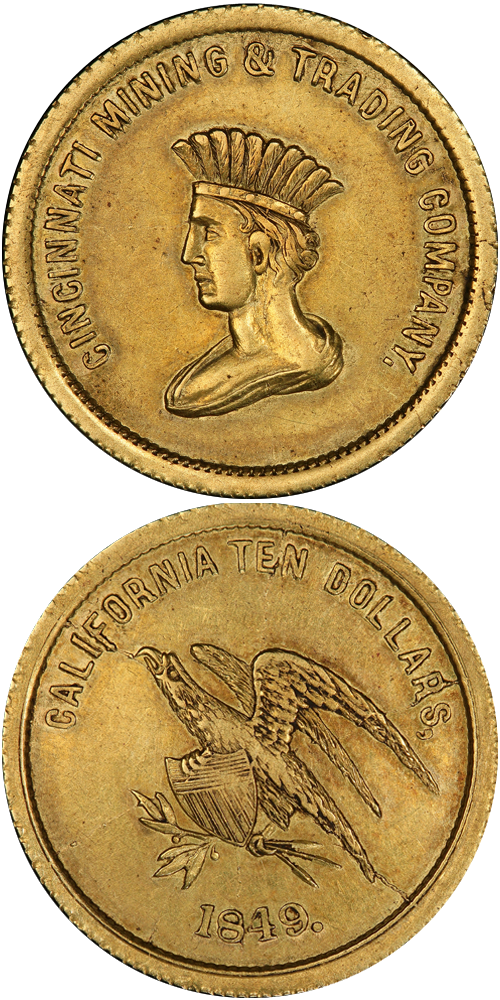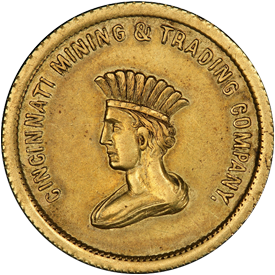The experience of the Cincinnati Mining & Trading Co. was perhaps typical of the unrealized coinage dream. Its activities are today shrouded by the veil of time, and its very existence at any time in California is uncertain. Contemporary accounts seem to indicate that members of the firm came overland, probably reaching California in the autumn of 1849.
Edgar H. Adams, in his monumental reference Private Gold Coinage of California, 1849-1855, noted that Almarin B. Paul of San Francisco, who conducted an extensive business in Sacramento in 1849 and 1850, and through whose hands passed many of the private gold issues, stated that neither he nor any of the pioneers with whom he had consulted remembered seeing coins of the Cincinnati Mining & Trading Co. in circulation. Both John J. Ford, Jr. and Don Kagin, present-day specialists in western proprietary issues, are of the opinion that the Cincinnati Mining & Trading Co. coins were actually struck in San Francisco, in limited amounts, in the autumn of 1849. It is their belief that the firm of Broderick (later United States senator) & Kohler (later State Assayer) were the issuers, having apparently acquired the Cincinnati Mining & Trading Co. dies from members of that company when it disintegrated upon reaching California.
The company seems to have been one of many composed in the East by investors eager to reap profits by producing coins in California. The firm was officially known as the California Mining & Trading Co. of Cincinnati, Ohio. J. H. Leavering served as president, W. B. Norman as vice-president, David Kinsey as Treasurer, Samuel T. Jones as secretary, and A. H. Colton as bookkeeper. The firm's Board of Finance was composed of Joseph Talbert, C. W. Letter, and L. M. Rogers. Nearly four dozen other individuals were included in the lengthy roster of the company's regular members.
The Cincinnati Gazette reported on March 10, 1849 that the steamer Bay State under the command of Capt. Collier departed from Cincinnati for a trip down the Ohio River with the Cincinnati Company on board. Another paper, The New York Tribune of March 18, 1849 stated that on that same March 1Oth date, the members of the Cincinnati Company started overland by way of St. Louis. The same periodical on July 7, 1849 printed a letter dated May 17th written to a Cincinnati newspaper by a member of an overland company. While the company name was not mentioned, Adams was of the belief that the Cincinnati adventurers were the ones being referred to. "Coining apparatus" intended for use in California is specifically mentioned. The letter was posted from Fort Childs located 300 miles to the west of Independence, Missouri:
"On the 10th we arrived at the junction of St. Joseph's Road and in the course of the morning saw so many wagons that we thought we must lighten our loads and get in advance of the tide of emigration, or our mules and oxen must suffer in consequence of short feed; therefore about noon we stopped and held a meeting, and passed a resolution appointing a committee to examine all the wagons and throw out and abandon everything that was not absolutely necessary. Accordingly, we left behind the wagon that we purchased for carrying corn, which cost $210; blacksmith tools, consisting of anvil, forge, sledge-hammers, etc.; about 200 mule shoes, several extra axle-trees, and came very near leaving the coining apparatus, most of the company being in favor of doing so, it being very heavy. We also changed the sugar, rice, etc., from boxes into bags. While we were engaged in this business a train of over 50 wagons passed. They reported that they had passed between 600 and 700 wagons since they left at St. Joseph's, and that a great many of them had to throw away part of their loading, almost everyone loading too heavy. One team they passed had abandoned 1,200 pounds of bacon, among other things. So many trains have started that fears are entertained that they cannot all get through, as there will not be grass enough for the animals. This and the anxiety to get to the gold as soon as possible, are the causes of property being abandoned. Among the wagons that passed us was one train from Georgia with a carriage or hack containing a man and his wife; that train also had several Negroes with them. Our wagons are made too heavy and strong. There are none like them. Other trains have just such as come out of the market at Cincinnati, many of them poorer. We might have saved $600 and had wagons more suited for the trip.
There are two companies of regulars, mounted riflemen, stationed here for the protection of the encampments. I stopped at the store and found it full, there being two or three trains encamped close by. Among them is one of thirty wagons from Alton, Illinois. Almost every article can be had at an advance from 200 to 400 percent over prices in the United States. The sale of liquor was yesterday prohibited by an order from the officer at the fort. One man told me that he bought, previous to the order being given, 15 gallons at 30¢, and had since been offered $8 per gallon. The houses, consisting of about a dozen, are built of turf or sod cut from the prairies, having a frame of wood inside, wood being very scarce — the nearest on this side of the Platte being 30 miles. We have been all fore- noon picking up what wood we cooked our dinner with, finding it stick and chip at a time, from old encampments.
We first came in sight of the Platte yesterday, and struck it at the head of the "Grande Island," as it is called, being an island 90 miles long. Near us are encamped a wagon and six men, Mormons, just from California. I saw a specimen of the dust, it is in scales, about the size of a large pin head hammered out. According to their account, there is enough for all who go; but, like some other places, it takes hard work to procure it. The specimen I saw weighed just $10, pure gold — this was all they had convenient. I asked them how much they had made. They said they had dug until they were satisfied, and had all they wanted, which must be a large amount, if they are as greedy as some of us. One of them told me the most he ever made in the shortest time was $750 in half a day; he said they averaged $150 per day apiece."
Among California gold coins, issues of the Cincinnati Mining & Trading Co. can legitimately be called "the rarest of the rare." Gold impressions are known of just two denominations: the $5 and $10 issues. Don Taxay was able to locate just one impression of the half eagle in gold, the example presently in the Smithsonian Institution. Of the eagle, just three specimens were located by him.







